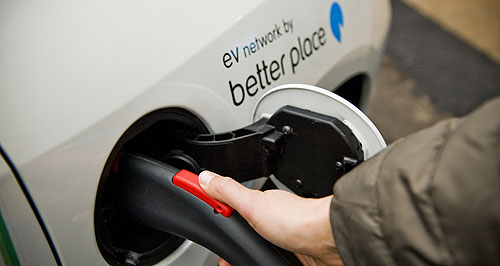Make / Model Search
News - General NewsRACV tips $2 million into Better PlacePlugged in: Victoria's RACV has put its hand in its pocket to invest in EV charging company Better Place Australia. Victorian auto club invests in EV charge-point provider Better Place Australia23 Mar 2010 THE giant Royal Automobile Club of Victoria (RACV) is making a $2 million investment in electric vehicle (EV) service provider Better Place Australia. The news comes after two-year-old Better Place announced it had raised $25 million in an initial funding for infrastructure it plans to begin rolling out around Australia late next year. Other Australian investors include Lend Lease and Canberra-based energy provider, ActewAGL. Earlier this year, the San Francisco based Better Place parent company announced it had raised $US350 million of new equity financing from a group of investors including the HSBC Group. Talking up its planned electric charge and battery swap network at last week’s Australasian Fleet Managers Association conference in Melbourne, Better Place CEO and former Victorian Labor politician, Evan Thornley, spoke of swelling support for his operation. “There is something very big happening out there and that is why that volume of money from in many cases very sophisticated and conservative investors is moving very quickly,” he said. RACV general manager public policy Brian Negus said the RACV was forming what it calls a ‘forward-looking’ partnership with Better Place.  “This strategic investment in the Better Place project is a demonstration of RACV’s commitment to sustainable transport technologies,” he said. Mr Negus said its tie-up with Better Place would include the provision of charge spot installations at RACV properties, roadside assistance services as well as insurance cover for EVs and joint marketing activities. While the widespread adoption of EVs in Australia is expected to lag behind Europe, Japan and the US due to the lack of any federal government incentives for imported electric vehicles, Better Place says it will have the infrastructure in place regardless of how many EVs will be able to use it. “It is important to understand that this opportunity will happen faster in Australia than other parts of the world,” Mr Thornley said. “We at Better Place are rolling out our infrastructure. “The first country is Israel, which will have a full charge network up and running by mid 2011. “We will follow shortly after that in Denmark and our third national charge network anywhere in the world will be here in Australia.” Mr Thornley said it was likely Australia would lead the world. “Unless someone moves very quickly somewhere else in the world, by the end of 2013, the largest charge network anywhere in the world will be here.” Mr Thornley said it would cost $600 million to set-up the network. When asked by GoAuto if Better Place would need a reasonable amount of cars on Australian roads, which could take several years, for its network to be viable, Mr Thornley said: “We do, but we have patient investors. They understand the dynamics of how these things work,” he said. He went on to suggest making money would not be an issue for Better Place. “We have got a $40 billion gasoline market we can take to pieces,” he said. “It will take a few years, but I can build a national charge network for $600 million to take on a $40 billion gasoline market, so the number of vehicles we would need running on that network for us to break even is relatively small.” The ABC has since reported Better Place has predicted 10 to 20 per cent of vehicles in Australia would use electricity by 2020 and that the entire national fleet will be electric by 2035. The Better Place infrastructure plan includes several charging centres and battery swap facilities, which it believes will allow easy long distance driving in electric vehicles. The idea is that Better Place would own the batteries, the customer would pay a subscription fee and would be free to have them switched if caught out by limited range. Better Place said a battery could be changed over in less than 75 seconds. Quick-charge facilities, as proposed by Japanese car-makers pushing for a global standard for the system, could challenge the relevance of the battery swap model, but Better Place is confident it will be the best solution for some time. That enthusiasm is not shared by everyone. General Motors is convinced it has the right idea with the Chevrolet Volt, a plug-in range-extender electric vehicle that can travel around 60km before switching to a petrol generator to eliminate what it calls electric vehicle range anxiety. Nissan has confirmed the batteries for its Leaf electric vehicle will not be compatible with the Better Place swap system. BMW board member for development, Dr Klaus Draeger recently told Drive that battery swap programs were “not a real solution” because the electrical system of its cars would be too complex. He also voiced concern that the batteries would be owned by Better Place and therefore the technology and chemistry would have to be locked in, not advanced, to ensure the batteries were interchangeable.  Read more19th of March 2010  Nissan’s green Leaf uncoveredNissan promises affordable electric car as Leaf nears production15th of March 2010  Electric-vehicle freeze-out threatAustralia could be green-car backwater without incentives for importers, says FCAI29th of January 2010  Better Place secures $388 million in EV investmentElectric vehicle network and Nissan-Renault partner set for global and Aussie launch |
Click to shareGeneral News articlesResearch General News Motor industry news |











Facebook Twitter Instagram